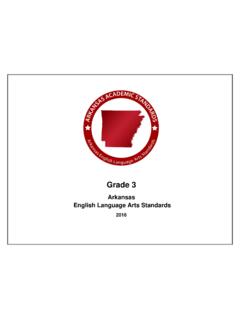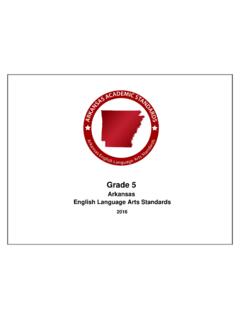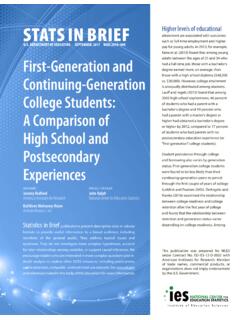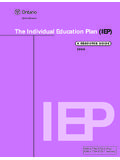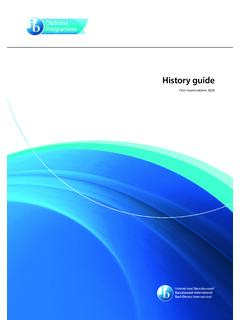Transcription of Kindergarten - Arkansas Department of Education
1 Kindergarten Arkansas English Language Arts Standards 2016 2 Kindergarten ELA Arkansas English Language Arts Standards Arkansas Department of Education 2016 Kindergarten Table of Contents 3 How to Read This 4 Arkansas Anchor Standards for 7 Kindergarten Reading Standards for 8 Kindergarten Reading Standards for Informational 10 Kindergarten Reading Standards for Foundational 12 Arkansas Anchor Standards for 17 Kindergarten Writing 18 Arkansas Anchor Standards for Speaking and 22 Kindergarten Speaking and Listening 23 Arkansas Anchor Standards for 25 Kindergarten Language 27 30 32 3 Kindergarten ELA Arkansas English Language Arts Standards Arkansas Department of Education 2016 Introduction The Arkansas English Language Arts Standards for Grades K-12 have been developed to prepare students for success after high school.
2 Students who are successful in college and careers have attained particular literacy capacities. These students demonstrate independence; build strong content knowledge; respond to the varying demands of audience, task, purpose, and discipline; comprehend as well as critique; value evidence; use technology and digital media strategically and capably; come to understand other perspectives and cultures. The English classroom focuses on reading and analyzing literature and literary nonfiction, studying the English language, and writing about related topics.
3 A separate document, the Arkansas Disciplinary Literacy Standards, has been created to address the unique literacy needs in other content areas. This document is organized around anchor standards and grade-level standards. The anchor standards address overarching knowledge and skills in reading, writing, speaking and listening, and language. Although the document is organized by strands, the standards should be integrated during instruction. The grade-level standards, which are aligned to the anchor standards, represent the progression of learning for Grades K-12.
4 The grade-level standards include teacher notes that provide explanations, definitions, and links to resources to support teachers. The document focuses on literacy skills rather than literary content. Teachers have the opportunity to select grade-appropriate literature and literary nonfiction texts to teach the standards. The texts must provide opportunities to teach all the strands at grade-level rigor. Three measures of text complexity should guide text selection: quantitative, qualitative, and reader and task.
5 Teacher notes in the grade-level documents provide support for effective text selection. Teachers are encouraged to become familiar with the standards above and below the grade level they teach. The standards below grade level will guide decisions for providing interventions for students who do not have all the grade-level skills in place, and the standards above grade level will guide decisions for extending students who are ready to move ahead. In addition, familiarity with the K-12 standards will support developing a smooth learning progression from Kindergarten through high school.
6 The Arkansas Department of Education academic standards are intended to assist in district curriculum development, unit design, and to provide a uniform, comprehensive guide for instruction. The standards are not intended to be a state-mandated curriculum. 4 Kindergarten ELA Arkansas English Language Arts Standards Arkansas Department of Education 2016 5 Kindergarten ELA Arkansas English Language Arts Standards Arkansas Department of Education 2016 6 Kindergarten ELA Arkansas English Language Arts Standards Arkansas Department of Education 2016 7 Kindergarten ELA Arkansas English Language Arts Standards Arkansas Department of Education 2016 Arkansas Anchor Standards for Reading The standards on the following pages define what students
7 Should understand and be able to do by the end of the grade or grade span. The grade-specific standards correspond by number to the Arkansas Anchor Standards for Reading. The Arkansas Anchor Standards and grade-specific standards are necessary complements--the former providing broad standards, the latter providing additional specificity--that together define the skills and understandings that all students must demonstrate. Key Ideas and Details 1. Read closely to determine what the text says explicitly and to make logical inferences from it; cite specific textual evidence when writing or speaking to support conclusions drawn from the text.
8 2. Determine central ideas or themes of a text and analyze their development; summarize the key supporting details and ideas. 3. Analyze how and why individuals, events, and ideas develop and interact over the course of a text. Craft and Structure 4. Interpret words and phrases as they are used in a text, including determining technical, connotative, and figurative meaning; analyze how specific word choices shape meaning and/or tone. 5. Analyze the structure of texts, including how specific sentences, paragraphs, and larger portions of the text ( , a section, chapter, scene, stanza) relate to each other and the whole.
9 6. Assess how point of view, perspective, and/or purpose shape the content and style of a text. Integration of Knowledge and Ideas 7. Integrate and evaluate content presented in diverse media and formats. 8. Analyze and evaluate the argument and specific claims in a text, including the validity of the reasoning as well as the relevance and sufficiency of the evidence. 9. Analyze how two or more texts address similar themes or topics in order to build knowledge or to compare the approaches of the author(s).
10 Range of Reading and Level of Text Complexity 10. Read and comprehend complex literary and informational texts independently and proficiently. Note on Range and Content of Student Reading Grades K-5 To build a foundation for college and career readiness, students must read widely and deeply from among a broad range of high-quality, increasingly challenging literary and informational texts. Through extensive reading of stories, dramas, and poems from diverse cultures and different time periods, students gain literary and cultural knowledge as well as familiarity with various text structures and elements.






